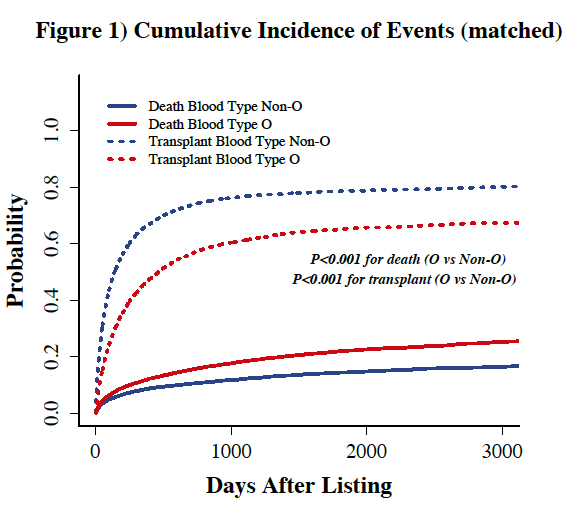Is the Current Heart Allocation System Just and Fair for Blood Type O Recipients? – A Propensity-Matched Analysis of 34353 Patients in the UNOS Registry.
Columbia University Medical Center, New York, NY
Meeting: 2017 American Transplant Congress
Abstract number: 202
Keywords: Allocation, Heart transplant patients, Outcome, Survival
Session Information
Session Time: 8:30am-9:30am
 Presentation Time: 8:45am-9:00am
Presentation Time: 8:45am-9:00am
Location: Arie Crown Theater
Purpose: There is a known disparity between the waiting time on heart transplant (HTx) between blood type O and non-O recipients. This difference is mainly attributed to the fact that O hearts can be allocated to any recipient, but the effect of this allocation disadvantage for O recipients has been rarely shown in a large registry. The purpose of the current study is to compare the outcomes in O and non-O HTx recipients.
Methods: We reviewed the UNOS registry for adults listed for HTx from 2000 to 2015. Demographic data and outcomes between O and non-O were compared. Baseline differences were adjusted by propensity matching using covariates at listing.
Results: Before matching, 34353 patients were included (19430 for non-O and 14923 for O). At listing, age was lower in O (53.0±11.8 vs 52.3±12.1, p<0.001, non-O vs O), LVAD was higher in O (13.5 vs 16.6%, p<0.001), and ischemic cardiomyopathy was lower in O (43.5% vs 38.7%, p<0.001). After matching, 14593 patients were included in each group with median follow-up 1053 days from listing. LVAD at listing was similar (15.5 vs 15.7%, p=0.617), but LVAD at Htx was higher in O (24.1 vs 31.4%, p<0.001). HTx were more frequently performed in non-O as compared to O patients (72.7 vs 57.5%, p<0.001), with 18.9% non-O recipients receiving type O hearts. Although survival after HTx was similar, cumulative incidence of HTx was lower in O (p<0.001), and survival from listing was worse in O (p<0.001).
Conclusions: O recipients demonstrated worse long-term outcomes after listing. Broader sharing for the sickest patients, an important component of the newly proposed allocation policy may alleviate this disparity. 

CITATION INFORMATION: Ando M, Takeda K, Kurlansky P, Wright M, Lee C, Han J, Garan A, Topkara V, Yuzefpolskaya M, Colombo P, Farr M, Naka Y, Takayama H. Is the Current Heart Allocation System Just and Fair for Blood Type O Recipients? – A Propensity-Matched Analysis of 34353 Patients in the UNOS Registry. Am J Transplant. 2017;17 (suppl 3).
To cite this abstract in AMA style:
Ando M, Takeda K, Kurlansky P, Wright M, Lee C, Han J, Garan A, Topkara V, Yuzefpolskaya M, Colombo P, Farr M, Naka Y, Takayama H. Is the Current Heart Allocation System Just and Fair for Blood Type O Recipients? – A Propensity-Matched Analysis of 34353 Patients in the UNOS Registry. [abstract]. Am J Transplant. 2017; 17 (suppl 3). https://atcmeetingabstracts.com/abstract/is-the-current-heart-allocation-system-just-and-fair-for-blood-type-o-recipients-a-propensity-matched-analysis-of-34353-patients-in-the-unos-registry/. Accessed December 20, 2025.« Back to 2017 American Transplant Congress
